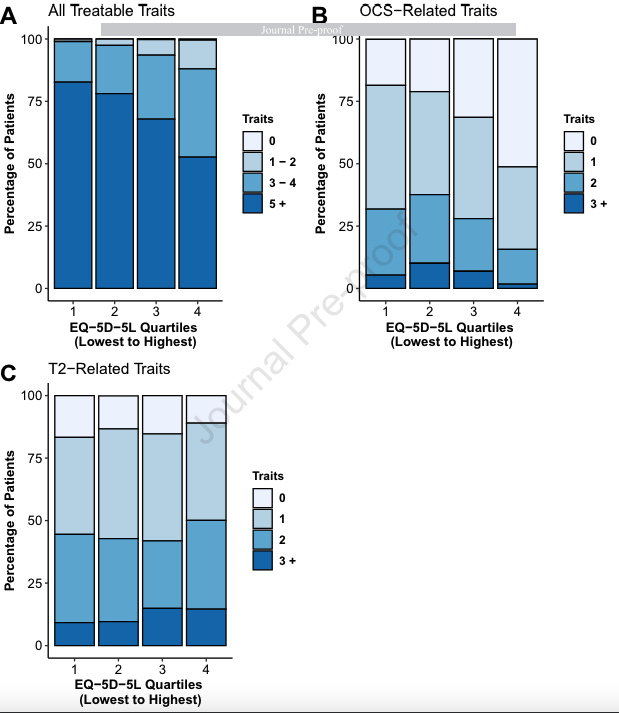
Pfeffer, Paul E. Brown, Thomas Chaudhuri, Rekha Faruqi et al. Journal of Allergy and Clinical Immunology: Global, Volume 0, Issue 0, 100286
Highlights & Clinical Implications
What is already known about this topic?
Patients with severe asthma often have an impaired quality of life due to respiratory symptoms and the limitation to daily activities resulting from those symptoms.
What does this study add to our knowledge?
The presence of extra-pulmonary traits, especially comorbidities associated with cumulative oral corticosteroid exposure, is associated with worse quality of life in severe asthma. Reduction in exacerbations, requirement for maintenance oral corticosteroids and asthma symptoms is associated with improvement in quality of life during follow-up in a severe asthma service. The presence of extra-pulmonary traits at baseline does not affect whether a patient’s quality of life can improve during follow-up.
What are the clinical implications?
It is important to diagnose severe asthma and commence biologics before patients develop comorbidities associated with systemic corticosteroids given their impact on quality of life, but patients who have those comorbidities still benefit from specialist treatments.
Abstract
Background
Severe asthma pathology encompasses a wide range of pulmonary and extra-pulmonary treatable traits with a high prevalence of comorbidities. Although asthma-specific health related quality of life measures are most sensitive to changes in asthma control, generic measures, such as EQ-5D-5L (EuroQol 5-Dimension 5-Level questionnaire), are potentially better for capturing the impact of comorbidities.
Objective
To examine the impact of pulmonary and extra-pulmonary treatable traits on quality of life at initial severe asthma assessment, and to compare the characteristics of those patients whose quality of life does and does not improve during follow-up at severe asthma centres.
Methods
Patients characteristics at baseline assessment within the UK Severe Asthma Registry were compared by EQ-5D-5L utility index quartile. Patients with follow-up review data were stratified by change in EQ-5D-5L utility index from baseline to follow-up, and characteristics similarly examined.
Results

Patients in the quartiles with worst dysutility at baseline were observed to exhibit more treatable traits and in particular extra-pulmonary traits associated with cumulative systemic corticosteroids, including obesity, anxiety/depression, and osteoporosis. In those patients whose quality of life improved over follow-up, a reduction in exacerbations, uncontrolled symptoms and requirement for maintenance oral corticosteroids (OCS) was observed.
Conclusion
Both pulmonary and extra-pulmonary treatable traits are important determinants of quality of life in severe asthma. Comorbidities associated with cumulative systemic corticosteroid exposure are particularly associated with worse quality of life, emphasising the importance of early identification and management of severe asthma before comorbidities develop.
